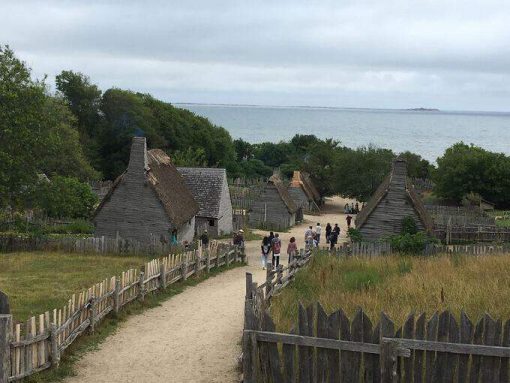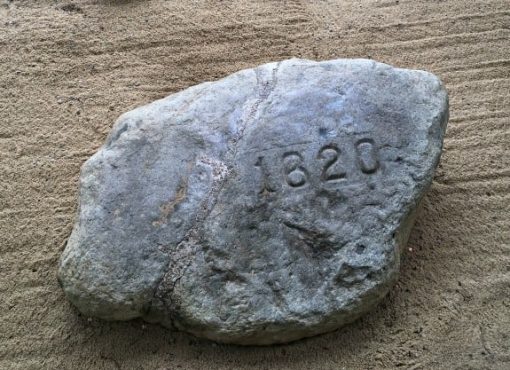Just about every history book tells of the Pilgrims sailing aboard the Mayflower in 1620 across the Atlantic Ocean. The Pilgrims arrived in the New World and established Plymouth Colony in the area now identified as the city of Plymouth and America’s Hometown.
It is known that the Mayflower made landfall in Plymouth Harbor, but it is at this point that history takes a debatable turn from facts and perhaps more to folklore. Stories relate the Pilgrims reached shore by using a large rock as a stepping stone. There is no documentation stating this or marking the exact stone, yet in 1741 the elderly son of an early Plymouth settler, identified a rock and it has forever more been known and honored as Plymouth Rock.
Stepping forward nearly 400 years, visitors to Plymouth, Massachusetts can visit that same stone, now a national monument. The Rock is slightly smaller than it originally appeared to the Pilgrims as over the decades souvenir hunters have chipped away at the stone until it is approximately one-third its original size. Plymouth Rock is carefully housed within a protective enclosure on the grounds of the 11-acre Pilgrim Memorial State Park that offers views of the historic Harbor. Guests can stand within the columned walls of the building and peer down at the engraved “1620” Rock resting in the sand below.
The Mayflower II, a replica of the original ship that transported the Pilgrims, is also located in the waterfront park. Over one million visitors come annually from around the world to view the historic site. Visitors can observe both Plymouth Rock and The Mayflower II free of charge. For an additional fee, patrons can climb aboard the anchored ship to experience the dark, cramped conditions the Pilgrims endured during the voyage. The upper deck was reserved for the crew, as was the kitchen facilities where hot meals could be prepared. The Pilgrims were restricted to the windowless lower deck that surely enhanced their sea-sickness.
The harbor is popular with a number of fishing, sight-seeing and whale-watching charters departing from here as well as a cluster of shops and restaurants. Limited free parking is available within Pilgrim Park, while metered parking is positioned along the street. A word to the wise, the meters are closely monitored so I would advise keeping an eye on your watch or setting an alarm on your phone.
For a full day immersed in 17th Century, include a visit to the re-created Plimoth Plantation. The spelling of Plimoth is adapted from writings of Governor William Bradford. While not on the exact location of the original Colony, the Plantation provides guests with a convenient living history experience that focuses on the lives of the early settlers and the Wampanoag Indians. Visitors encounter true Native Peoples within the Wampanoag site and role playing staff around the village. To really appreciate the experience, listen and engage in conversation with both as they perform household tasks, farm chores and daily activities.
A Craft Center serves to showcase historic crafts and revive the techniques and tools used in the 17th Century. From intricate Native headdresses, hand dipped candles and pottery, items produced here have been used to furnish the Plantation homes and are available for purchase in the Museum Shop.
Another section of the Craft Center that creates quite a stir is the Plimoth Bakery. The Bakery uses recipes and techniques that are nearly 400 years old, yet tweaked to meet modern health standards to create bread and sweets that were created by the Pilgrims and Wampanoag Indians. While you might find easy to sanitize plastic proofing baskets, you won’t find any electric mixers and the oven is wood fired. Ingredients used in the recipes include items grown in the Plantation gardens with flour and cornmeal from the Plimoth Grist Mill.
The Plimoth Grist Mill is located in the center of Plymouth, just a short walk from Mayflower II. Construction of the Grist Mill was commissioned by the Colony in 1636 after hand grinding corn for over a decade. The Grist Mill was constructed to use the power of Town Brook to more efficiently produce cornmeal. A sensory experience on days when the Mill is operating, guests can smell the corn, hear the kernels crack and feel the vibration of the massive wheels. Be sure to call ahead to ensure the Mill will be operating on the day of your visit.
Admission tickets can be purchased in combinations to include one, two or all of the Plimoth Plantation Museums which includes Plimoth Plantation, Mayflower II and Plimoth Grist Mill. All admission fees help support and maintain the properties. The re-created Village is open from the second Saturday in March through the end of November. The Plantation Visitors Center is open year round as is Pilgrim Memorial State Park.
Photo credits: J. Ingersoll
Share as a Pin to your Pinterest Travel Board
 00
00
You might also enjoy
Having been transplanted numerous times, I have learned to explore the sites around our new found hometown, uncovering hidden gems and attractions. When vacation time rolls around, I enjoy traveling with my family and the occasional weekend escape with my husband, coming home to share our travel experiences with others. You can follow me on Twitter @JAIngersoll. My top three destinations are Walt Disney World Resort, the Midwest and any beach I can walk along.










